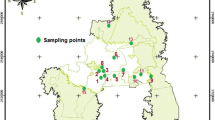Abstract
In order to explore the mechanism of moss as air pollution biomonitor, the moss samples were exposed in a pollution site of Shanghai Institute of Steel Research (SISR) and a control site of Shanghai Institute of Applied Physics (SIAP) simultaneously for one month. The concentrations of trace elements in the micro areas of leaf and stem, as well as in the whole moss tissue, were determined using synchrotron radiation X-ray fluorescence (SRXRF) method. The distributions of some metal elements such as Pb, Cu, Fe, Ni, Mn, Zn, Ca and K in the leaf surface and the stem slice were obtained. The results showed that the metallic ions were not evenly distributed after adsorption. In particular, some elements of K, Ni, Fe, Pb, etc., were concentrated in the leaf apex and the intermediate rib. Under pollution condition, the excessive Pb was adsorbed and deposited in the leaf. It caused serious damage to plant growth and ultrastructure, also suppressed moss’ normal absorption to the nutritive elements of K, Ca, etc.
Similar content being viewed by others
References
Szczepaniak K, Biziuk M. Aspects of the biomonitoring studies using mosses and lichens as indicators of metal pollution. Environ Res, 2003, 93: 221–230
Wolterbeek B. Biomonitoring of trace element air pollution: principles, possibilities and perspectives. Environ Pollut, 2002, 120: 11–21
Wolterbeek B, Verburg T G. Judging survey quality: Local variances. Environ Monit Assess, 2002, 73: 7–16
Maurizio A, Ornella A, Raffaele C, et al. The use of mosses as environmental metal pollution indicators. Chemosphere, 2003, 50: 333–342
Knor I B, Naumova E N. Biological monitoring of meadow moths by SR-XRF technique. Nucl Instr Meth, 1995, A359: 324–326
Atsuo I, Takashi N. Synchrotron X-ray muprobe and its application to human hair analysis. Nucl Instr Meth, 1993, B82: 129–138
Espen P V, Nullens H, Adams F. A computer analysis of X-ray fluorescence spectra. Nucl Instr Meth, 1977, B142: 243–250
Atsuo I. X-ray spectrometric applications of a synchrotron x-ray microbeam. X-ray Spectr, 1997, 26: 359–363
Fernandez J A, Aboal J R, Carballeira A. Identification of pollution sources by means of moss bags. Ecotox Environ Safety, 2004, 59: 76–83
Joohyoung L, Perry J, Eunju L. Correlation between environmenral conditions and the distribution of mosses exposed to urban air pollutants. Water Air Soil Pollut, 2004, 153: 293–305
Author information
Authors and Affiliations
Corresponding author
Additional information
Supported by the National Natural Science Foundation of China (Grant No. 10775170), Major Project of Knowledge Innovation Program of Chinese Academy of Sciences (Grant No. KJCX3.SYW.N3), Key Project of Natural Science Foundation of Shanghai (Grant No. 08390513800), Project of Japan KEK, PF-PAC (Grant No. 2007G504) and National Laboratory of BEPC (Grant No. VR-07004)
About this article
Cite this article
Zhang, Y., Cao, T., Atsuo, I. et al. Study of moss as air pollution monitor by SRXRF technique. Chin. Sci. Bull. 54, 2987–2990 (2009). https://doi.org/10.1007/s11434-009-0320-2
Received:
Accepted:
Published:
Issue Date:
DOI: https://doi.org/10.1007/s11434-009-0320-2




